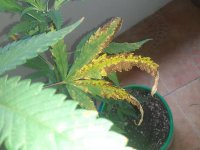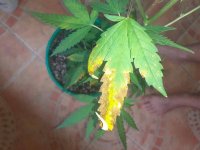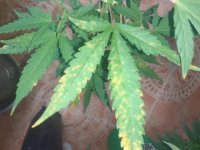Overwatering:
Soil moisture that is not absorbed rapidly turns stagnant; the plant quickly uses up any oxygen within the water, then is unable to respire further, resulting in moisture low in o2.
Pythium thrives in low-oxygen (anaerobic) conditions.
in short, overwatering will slowly suffocate your roots, preventing sufficient oxygen uptake by the roots, and ultimately causing root rot.
Light Deprivation
Although your plant may be receiving light, particular strains may require higher light levels than others.
A recommended light level for full bud development is 50 watts/m2. Edit: per square foot.
Full sunlight is 100,000 lumens max.
Low Nutrient Strength
The plant is unable to acquire the necessary amounts of nutrients to sustain high growth rates.
Large and mature plants can take higher nutrient strengths.
Nutrient strength is also related to the light intensity; plants under fluorescent lights usually require a lower nutrient concentration than under HIDs.
Nutrient Lock-up
Adding too much of a nutrient (ex. Magnesium) can "lockup" one or more nutrients, rendering them chemically unavailable to the plant.
Nutrient lockup can occur at extreme pH ranges (ie. under 5.0, over 7.0).
Light Spectrum
Light that does not contain enough red spectrum (too much blue).
Light spectrum can have a dramatic effect on plant growth, with different light frequencies affecting different photosynthetic processes within the leaf.
Selecting a blue spectrum in a vegetative growth phase is preferred, with red spectrum in flowering.
PH
pH is too high or too low (ie. acidic soil. The plants come out as mutants).
Plants are unable to absorb nutrients, or in adequate quantities within certain pH ranges.
Optimum pH varies with each medium.
Hydroponics and aeroponics: 5.6-5.8.
Soilless: 6.0-6.3
Soil: 6.5-7.0.
Some soilless mixtures can be fairly acidic, due to their high % bark content.
Low Temperatures
Plant metabolism will decrease at low temperatures. Chemical reactions within the plant will take longer.
Optimum plant growth often requires close temperature regulation; daytime temperatures between 25C and 30C are preferred.
Differences in the daytime and nighttime temps should not be dramatic, as this difference may shock the plant.
Low Soil Temperatures
Evaporation from a medium (i.e. peat pots) tends to chill the medium quite a bit due to the evaporative cooling effect.
As the peat pot warms, it draws moisture outward, the evap effect cools the peat (like sweating).
New growers often make the mistake of adding excessive amounts of water, resulting in cold soil, poor root formation and slowed growth
(Original Source "Snoofer")
Happy growing y'all
Vandenberg
Soil moisture that is not absorbed rapidly turns stagnant; the plant quickly uses up any oxygen within the water, then is unable to respire further, resulting in moisture low in o2.
Pythium thrives in low-oxygen (anaerobic) conditions.
in short, overwatering will slowly suffocate your roots, preventing sufficient oxygen uptake by the roots, and ultimately causing root rot.
Light Deprivation
Although your plant may be receiving light, particular strains may require higher light levels than others.
A recommended light level for full bud development is 50 watts/m2. Edit: per square foot.
Full sunlight is 100,000 lumens max.
Low Nutrient Strength
The plant is unable to acquire the necessary amounts of nutrients to sustain high growth rates.
Large and mature plants can take higher nutrient strengths.
Nutrient strength is also related to the light intensity; plants under fluorescent lights usually require a lower nutrient concentration than under HIDs.
Nutrient Lock-up
Adding too much of a nutrient (ex. Magnesium) can "lockup" one or more nutrients, rendering them chemically unavailable to the plant.
Nutrient lockup can occur at extreme pH ranges (ie. under 5.0, over 7.0).
Light Spectrum
Light that does not contain enough red spectrum (too much blue).
Light spectrum can have a dramatic effect on plant growth, with different light frequencies affecting different photosynthetic processes within the leaf.
Selecting a blue spectrum in a vegetative growth phase is preferred, with red spectrum in flowering.
PH
pH is too high or too low (ie. acidic soil. The plants come out as mutants).
Plants are unable to absorb nutrients, or in adequate quantities within certain pH ranges.
Optimum pH varies with each medium.
Hydroponics and aeroponics: 5.6-5.8.
Soilless: 6.0-6.3
Soil: 6.5-7.0.
Some soilless mixtures can be fairly acidic, due to their high % bark content.
Low Temperatures
Plant metabolism will decrease at low temperatures. Chemical reactions within the plant will take longer.
Optimum plant growth often requires close temperature regulation; daytime temperatures between 25C and 30C are preferred.
Differences in the daytime and nighttime temps should not be dramatic, as this difference may shock the plant.
Low Soil Temperatures
Evaporation from a medium (i.e. peat pots) tends to chill the medium quite a bit due to the evaporative cooling effect.
As the peat pot warms, it draws moisture outward, the evap effect cools the peat (like sweating).
New growers often make the mistake of adding excessive amounts of water, resulting in cold soil, poor root formation and slowed growth
(Original Source "Snoofer")
Happy growing y'all
Vandenberg
Last edited:







